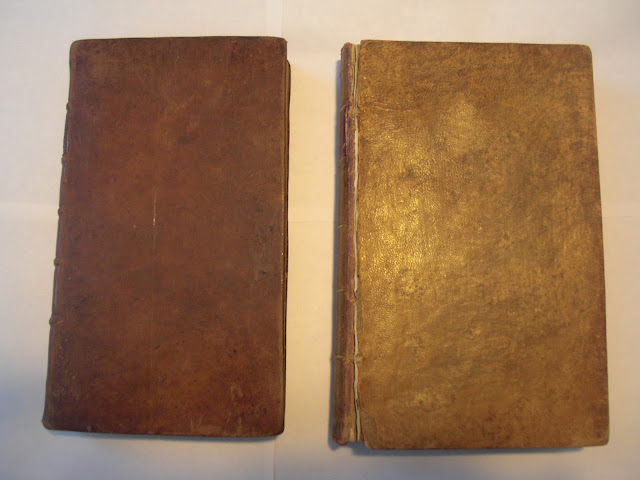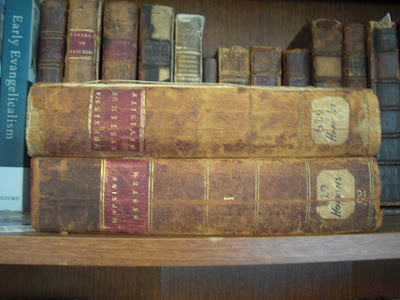According to Russell, the first major hurdle for evaluating the prices of eighteenth-century books pertains to colonial currency. In colonial America, each colony had its own paper currency, denominated in pounds, shillings, and pence. Like the British pound sterling, colonial pounds were worth twenty shillings (£1 = 20s.), with one shilling equaling twelve pence (1s. = 12d.). Complicating matters is that each colony's currency varied substantially throughout the eighteenth century. Pennsylvania and Delaware money was worth about 60% of the British pound sterling. Currency in New York and New York varied in value from about 55% to 60% of the British sterling.
Undoubtedly, the most problematic paper money in this period was issued in Massachusetts. For the first fifty years of the century, money was referred to as "Old Tenor" that inflated dramatically, so that by the late 1740s the Massachusetts pound was worth about one-ninth the value of the British pound sterling. At this point in the middle of the century, the British Crown reset the legal value of the Massachusetts pound (referred to as Lawful Money) so that its value equaled about 75% of the British pound sterling, and so that six shillings equaled one Spanish dollar (the basis for the American dollar). I have found John J. McCusker's Money Exchange in Europe and America, 1600-1775: A Handbook to be the most helpful source for analyzing colonial currency
Using McCusker's handbook, I began looking more closely at the prices of Jonathan Edwards's books in the eighteenth century, with provenance records, bookseller's advertisements, proposals, and account books serving as my sources. At this point, I have tabulated the prices of nearly all the editions of Edwards's books for that period.
A table for these three pamphlets, with prices in British pound sterling and Massachusetts Old Tenor currency would look like this:
| |||||||||||||||||||
After the Crown reset the value of Massachusetts money so that it was worth about 75% of the value of the British pound sterling in 1750, the costs of pamphlets in Massachusetts "Lawful Money" stabilized for much of the remaining years in the eighteenth century. This can be seen in the publication of some later pamphlets. When Wesley issued a second edition of Edwards's Distinguishing Marks at London in 1755, he sold the forty-eight page abridgement at the same price as before, 4d. This price of four pence would have worth five pence in Lawful Money. Wesley wanted his abridgements to be affordable for his itinerant preachers and Methodist society members. I have seen several Methodist pamphlets printed on course, brown paper, with uncut edges, and many times appearing as though they were read to death. Such evidence helps to explain why the Anglican clergyman Charles De Coetlogon's thirty-six page1774 edition of Edwards's sermon The Justice of God in the Damnation of Sinners sold at London for a slightly higher price of 6d., which was worth about 7d. in Massachusetts Lawful Money at that time. When De Coetlogon issued a new edition of The Justice of God in the Damnation of Sinners in 1788, it sold for the same price of 6d., and in that same year, the Anglican minister edited a thirty-two page edition of Edwards's sermon The Eternity of Hell Torments, which also sold from London for 6d.
Even though Wesley's pamphlets might have been cheaper than others, most early evangelicals purposely disseminated inexpensive Christian literature. I can cite at least one example to illustrate this point. At the bottom of the title page for a fifty-five page 1780 Northampton, England edition of Edwards's sermon The Excellency of Christ, edited by the English Particular Baptist John Collett Ryland, the price is listed in square brackets as 4d. "or 3s. per dozen to those who give them away." The prices of the pamphlets edited by Wesley, De Coetlogon, and Ryland demonstrate that Edwards's shorter works sold for roughly the same prices in England throughout the eighteenth century.
Analyzing the prices of Edwards's larger works is a bit more tricky. Besides factoring in Massachusetts's inflationary currency before 1750, one must also consider a particular edition's binding (whether it was stitched, or bound in a particular kind of leather), the quality of the paper, pagination, and additional features included in the book. As a case study, let's look at some of the editions of Edwards's Treatise Concerning Religious Affections.
 This book was first published at Boston in 1746 as a 358-page small quarto, and selling to subscribers for 28s. in Old Tenor, which would have been worth a little more than 4s. in British sterling at that time. In 1762, the London bookseller Thomas Field published a 288-page duodecimo abridgement of Religious Affections for 2s.6d. One can see that its smaller size necessitated that it should be priced at an equivalent cheaper rate. Several years after the first edition of Religious Affections was published in Boston, the New York bookseller Garrat Noel offered a 488-page octavo edition in 1768, "printed on a handsome type and neatly bound" for 8s. in New York currency, the same as 4s.4d. in British sterling. Notice at the end of Noel's advertisement that this edition boasts of having notes inserted and that the errors in the first edition had been corrected. This was one of the many marketing strategies that booksellers used to show the value of a new edition. In 1772, the London booksellers Charles and Edward Dilly published a 376-page octavo edition that was printed at Edinburgh, and advertised for 5s. Two years later in 1774, the London bookseller George Keith reissued Noel's 1768 edition, printing a new title page and falsely marketing this book as the "fourth edition" for 3s.6d. While we can't say for certain, what this London reissue seems to indicate is that Noel's book did not sell very well, and so perhaps Keith had the opportunity to buy the remainders and market his copies at a cheaper price in Britain.
This book was first published at Boston in 1746 as a 358-page small quarto, and selling to subscribers for 28s. in Old Tenor, which would have been worth a little more than 4s. in British sterling at that time. In 1762, the London bookseller Thomas Field published a 288-page duodecimo abridgement of Religious Affections for 2s.6d. One can see that its smaller size necessitated that it should be priced at an equivalent cheaper rate. Several years after the first edition of Religious Affections was published in Boston, the New York bookseller Garrat Noel offered a 488-page octavo edition in 1768, "printed on a handsome type and neatly bound" for 8s. in New York currency, the same as 4s.4d. in British sterling. Notice at the end of Noel's advertisement that this edition boasts of having notes inserted and that the errors in the first edition had been corrected. This was one of the many marketing strategies that booksellers used to show the value of a new edition. In 1772, the London booksellers Charles and Edward Dilly published a 376-page octavo edition that was printed at Edinburgh, and advertised for 5s. Two years later in 1774, the London bookseller George Keith reissued Noel's 1768 edition, printing a new title page and falsely marketing this book as the "fourth edition" for 3s.6d. While we can't say for certain, what this London reissue seems to indicate is that Noel's book did not sell very well, and so perhaps Keith had the opportunity to buy the remainders and market his copies at a cheaper price in Britain. In the last quarter of the eighteenth century, several American booksellers issued new editions of Religious Affections. In 1787, the New York bookseller Robert Hodge sponsored a 508-page octavo edition that was printed by Shepard Kollock at Elizabethtown, New Jersey. Subscribers could buy copies for 10s. and non-subscribers 12s. in New York currency (5s.6d./6s.6d. in British sterling). Notice in the advertisement to the left that Hodge's edition would contain a "Life of the Author" prefixed to the book. Although not mentioned in this advertisement, he also added an account of Esther Edwards Burr, some letters by her, as well as a biographical account of Edwards's wife Sarah Pierpont. Also worthy of notice, is the advertisement's appeal to become subscribers for this particular edition as a way of promoting the gospel message. All these features represent tactics by Hodge to increase the value of his edition.
In the last quarter of the eighteenth century, several American booksellers issued new editions of Religious Affections. In 1787, the New York bookseller Robert Hodge sponsored a 508-page octavo edition that was printed by Shepard Kollock at Elizabethtown, New Jersey. Subscribers could buy copies for 10s. and non-subscribers 12s. in New York currency (5s.6d./6s.6d. in British sterling). Notice in the advertisement to the left that Hodge's edition would contain a "Life of the Author" prefixed to the book. Although not mentioned in this advertisement, he also added an account of Esther Edwards Burr, some letters by her, as well as a biographical account of Edwards's wife Sarah Pierpont. Also worthy of notice, is the advertisement's appeal to become subscribers for this particular edition as a way of promoting the gospel message. All these features represent tactics by Hodge to increase the value of his edition.Several years later in 1794, the Philadelphia bookseller Mathew Carey published a 350-page octavo edition of Religious Affections for $1 on coarse paper and $1.50 on fine paper (7s.6d. and 11s.3d. in equivalent British currency). In the same year as Carey's edition, several Boston booksellers collaborated to bring out a 406-page duodecimo for $1, which would have been worth 7s.6d. in Britain.
Tabulating the prices and years of publication for these editions of Religious Affections looks like this:
| British Sterling | MA Old Tenor | MA Lawful Money | NY Money | PA Money | |
| 1746 | (4s.3d.) | 28s. | |||
| 1762 | 2s.6d. | ||||
| 1768 | (4s.4d.) | 8s. | |||
| 1772 | 5s. | ||||
| 1774 | 3s.6d. | ||||
| 1787 | (5s.6d./6s.6d.) | 10s./12s. | |||
| 1794 | (7s.6d./11s.3d.) | $1/$1.50 | |||
| 1794 | (7s.6d.) | $1 |
In order to understand the relative value of the various editions of Religious Affections, one must examine multiple copies, studying the quality of paper and bindings, as well as the format and pagination. However, a cursory glance at this information will show that the Dilly brother's 1772 Edinburgh edition was more expensive than George Keith's 1774 London reissue. Also significant is that the Dilly edition contained about one hundred less pages. The 500-page 1787 Hodge edition appears to be attractively priced when compared with the later Philadelphia and Boston editions in 1794, which were not only priced higher, but also contained significantly less pages.
In my forthcoming book on Jonathan Edwards and Transatlantic Print Culture, I will be spending more time diagnosing why some of Edwards's books were priced higher than others, and why some titles sold out while others became poor sellers.
















